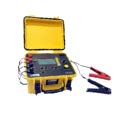The measurement of small resistance is widely used in preventive maintenance to check grounding continuity, surface metal conditions, contact resistance of switches and relays, and resistance of cables and windings to evaluate motor and transformer temperature conditions. For example, to detect metal joints. It covers a wide range of industries, including manufacturers in the automotive industry, telecommunications, transportation, motors and transformers, as well as companies that perform repairs and maintenance in these areas.
Measuring principle
The most basic principle of measuring resistance is Ohm's law: U = R × I. When the measured resistance is very low, the value is obtained by measuring the magnitude of the injection current and the voltage across the object to be measured. This connection method is called four-wire measurement, which is also called Kelvin bridge, which effectively avoids The effect of contact resistance or wire resistance when measuring small resistance.

The DC voltage source provides a voltage U and the current source provides a current I.
The voltmeter measures the voltage drop Ux across the measured resistance Rx to give Rx=Ux/I. This result is not affected by the Ri, Rf, Rc in the loop, as long as the total voltage drop caused by them and Rx is still lower than the voltage that the current source can provide. In practice, a retractable or rotating double needle probe or Kelvin clamp is used to better contact the object being measured. In general, when measuring devices such as rivets, two given test probes must have the ability to expand and contract.
The micro-ohmmeter must have a resolution of 1μΩ or even 0.1μΩ, a wide measurement range, and can measure the heat generated by the current, which is compensated by the thermocouple.
In order to ensure operator safety, the device must prevent accidental overvoltages and prevent the measurement from triggering the automatic discharge of the sensing object in the presence of interference voltage. Since the resistance of the metal changes significantly with temperature, it is a good idea to use a given reference temperature to display the measurement. The device has a powerful function that can be automatically performed at ambient temperature and reference temperature depending on the type of metal (temperature coefficient: copper or aluminum is approximately 0.4% / °C).
Selection guide



 Micro-Eurometer MOH700 (millimeter) CA6240 CA6250 AEMC6292 4-wire measurement mode â– â– â– â– Range 0.1mΩ-2000Ω 400μΩ-400Ω 5mΩ-2500Ω 0.1μΩ-1Ω Resolution 100μΩ-1Ω 1μΩ 0.1μΩ 0.1μΩ Maximum test current 100mA 10A 10A 200A Inductive/non-inductive/automatic â– Temperature compensation â– Reporting software â– â– â– USB/RS232 communication USB RS232 USB Storage 100 groups 1500 groups 8000 groups LCD display â– â– â– â– Power supply 5x1.5V
Micro-Eurometer MOH700 (millimeter) CA6240 CA6250 AEMC6292 4-wire measurement mode ■■■■Range 0.1mΩ-2000Ω 400μΩ-400Ω 5mΩ-2500Ω 0.1μΩ-1Ω Resolution 100μΩ-1Ω 1μΩ 0.1μΩ 0.1μΩ Maximum test current 100mA 10A 10A 200A Inductive/non-inductive/automatic ■Temperature compensation ■Reporting software ■■■USB/RS232 communication USB RS232 USB Storage 100 groups 1500 groups 8000 groups LCD display ■■■■Power supply 5x1.5V Alkaline battery powered by NiMH NiMH
100–240Vac
50/60Hz IEC61010 20VCATIV 50VCATIII 50VCATIII 300VCATII
Copyright statement: This information belongs to Beijing Ocean Industrial Technology Co., Ltd., if you need to reprint, please indicate the source!
Club Stool,Commercial Bar Stool,Club Leisure Stool,Restaurant Bar Stool
Foshan Livemate Appliance Co., Ltd. , https://www.livemate-furniture.com